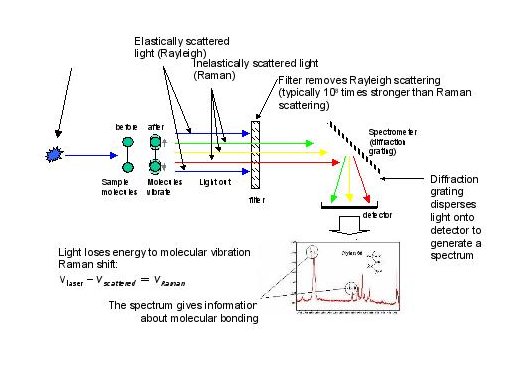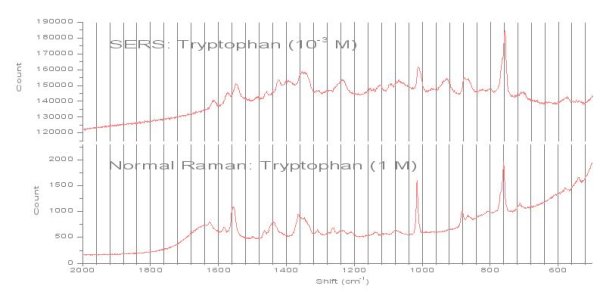
| Physics and Astronomy |
|
| Physics Home | Study here | Our Teaching | Our Research | Our Centres | News | Work here | EMPS |
Back to top
Surface Enhanced Raman SpectroscopyIntroductionRaman scattering of light by molecules may be used to provide information on a sample's chemical composition and molecular structure. Conventional Raman spectroscopy suffers from low signal strength, compared with other forms of optical spectroscopy such as fluorescence. As such it is not well suited to investigate molecular conformation in solution at low concentrations, which is a frequent requirement in life sciences. Surface Enhanced Raman Scattering (SERS) can increase the Raman signal by as much as 14 orders of magnitude, making SERS an attractive tool for future bio-physical investigation.  Principles of Raman Spectroscopy
Principles of Raman Spectroscopy
Surface Enhanced Raman Spectroscopy (SERS)Molecules absorbed onto specific metallic substrates (typically silver, gold and copper) exhibit enhanced in Raman signal. Enhancements reported as high as 1014. Increase in signal generated by chemical and electromagnetic field enhancement of vibrational modes. SERS using colloidal silver has been widely reported and is an ideal substrate for performing measurements in solution. When a solution of the sample molecule is mixed with a metal colloid the molecules are absorbed onto the surface of the colloids. The molecule is required to obtain molecular resonance and the surface attachment provides enhancement by interaction with the plasmons on the metal surface. Combined enhancement processes provide a Raman signal of equivalent sensitivity to that of fluorescence.  Comparsion of Raman and SERS spectra of Tryptophan. SERS signal acquired using citrate reduced silver colloid at 50% (v/v).
Comparsion of Raman and SERS spectra of Tryptophan. SERS signal acquired using citrate reduced silver colloid at 50% (v/v).
» Enhancement factor ~105
Different modes are enhanced by different amounts. Vibrational modes normal to the colloidal surface show greater enhancement. |
